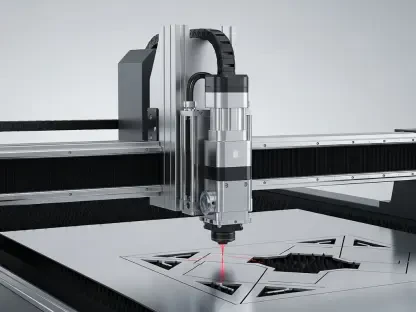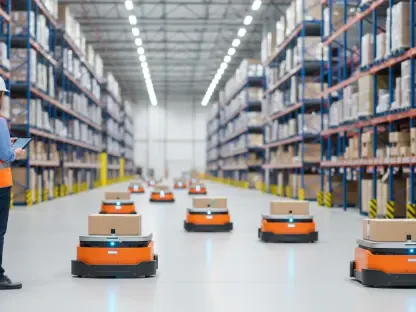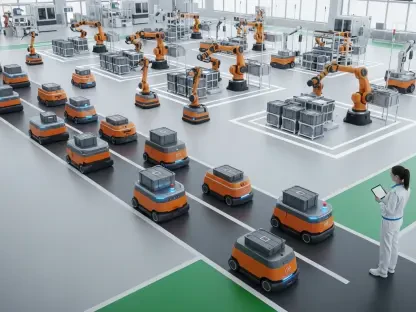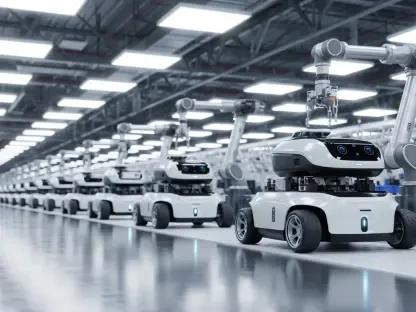As the calendar turns to 2025, China stands at the forefront of a robotics revolution, with humanoid robots capturing the imagination of industries and the public alike, marking this year as a defining moment characterized by unprecedented growth and a palpable buzz at major events like the World Artificial Intelligence Conference (WAIC) and the World Robot Conference (WRC). Production forecasts are staggering, with expectations of over 10,000 humanoid robots rolling off assembly lines, signaling a transformative era in automation. Yet, beneath this wave of excitement lies a turbulent undercurrent of chaos, particularly in the realm of hardware development. Manufacturers are grappling with supply chain disruptions and technical shortcomings that threaten to derail this rapid progress. The first half of the year has laid bare critical vulnerabilities, making it a pivotal time for the industry to address these challenges. This surge in robotics is not just about numbers; it’s a high-stakes race for innovation and global leadership, where overcoming hardware obstacles could set the stage for dominance in a future shaped by intelligent machines.
A Defining Moment for Robotics Growth
The robotics industry in China is experiencing a breakout year in 2025, with humanoid robots taking center stage as symbols of technological ambition. Events like WAIC and WRC have become showcases of this momentum, drawing massive crowds eager to witness machines that blur the line between science fiction and reality. Industry data underscores this boom, projecting a compound annual growth rate of nearly 80% from 2025 to 2030. Such figures highlight a trajectory that could redefine manufacturing, healthcare, and daily life. Beyond the spectacle, this growth reflects a deeper shift, as robots transition from niche experiments to potential mainstream solutions. Government support and private investment are fueling this ascent, positioning China as a global contender in automation technology.
This surge, however, is not without growing pains. The sheer speed of expansion has exposed gaps in infrastructure and readiness across the sector. While the public marvels at robotic displays, behind the scenes, companies face mounting pressure to deliver on these lofty promises. Scaling production to meet projected numbers requires more than enthusiasm—it demands robust systems and reliable components, both of which are currently in short supply. The spotlight on robotics in 2025 serves as both an opportunity and a warning: capitalize on this momentum now, or risk falling behind in a fiercely competitive global market. This defining moment is as much about overcoming immediate hurdles as it is about laying the groundwork for sustainable progress.
Hardware Challenges at a Critical Juncture
In the first half of 2025, the robotics hardware landscape in China has been marked by significant turmoil, revealing bottlenecks that could stall the industry’s rapid rise. A primary issue lies in the low localization rate of core components, forcing manufacturers to depend heavily on foreign suppliers for essential parts. This reliance creates a fragile supply chain, vulnerable to delays and cost fluctuations, which in turn hampers efforts to scale production efficiently. The stakes are high, as any disruption ripples through the entire ecosystem, delaying product rollouts and frustrating ambitious timelines. Addressing this dependency is not just a logistical concern but a strategic imperative for achieving autonomy in robotics development.
Compounding the supply chain woes is the lack of standardized technical solutions for the diverse needs of robotic applications. From industrial automation to personal service roles, customized demands are increasing, yet the industry struggles with inconsistent dynamic control accuracy and immature frameworks to meet these requirements. This fragmentation results in a patchwork of approaches among manufacturers, each trying to solve unique problems without a unified blueprint. Such disarray slows down the path to widespread adoption, as potential users hesitate to invest in unproven or incompatible systems. The chaos in hardware development during this critical period underscores the urgent need for cohesive strategies to stabilize the foundation of this burgeoning field.
Unpacking the Core of Robot Technology
At the core of every humanoid robot are intricate hardware systems that dictate functionality, split primarily into execution and perception categories. The execution system acts as the muscle, encompassing high-performance motors, precision reducers, and specialized components like planetary roller screws and bearings. These elements enable movement and strength, allowing robots to perform tasks ranging from lifting heavy loads to precise assembly. However, their production comes at a steep price, with screws alone accounting for a substantial portion of hardware expenses, often up to 19%. Sourcing these critical parts remains a persistent challenge, as the balance between quality and cost continues to elude many in the industry, impacting overall affordability and scalability.
Equally vital is the perception system, which equips robots to interact intelligently with their surroundings through advanced sensors. Force sensors, such as six-dimensional torque sensors, provide real-time feedback essential for maintaining balance and handling objects with care. These components are the eyes and ears of a robot, enabling nuanced responses to environmental changes. Despite their importance, securing a steady supply of reliable sensors poses a significant hurdle, often due to limited domestic production capabilities. The interplay between execution and perception systems forms the bedrock of robotic capability, yet the struggle to source and integrate these essentials highlights a broader issue of readiness within the sector to meet growing market expectations.
Supply Chain Woes and Global Dependencies
Delving into the supply chain dynamics of China’s robotics industry reveals a stark reality of dependency on foreign technology in 2025. Although domestic companies are making strides in producing components like harmonic reducers and precision screws, the market for critical hardware remains dominated by international giants. This imbalance creates a frustrating mismatch between the soaring demand for robotic parts and the limited availability from cautious suppliers. Many foreign firms adopt a “wait-and-see” stance, hesitant to commit to large-scale production due to relatively low shipment volumes, which currently hover in the hundreds. This reluctance exacerbates delays and drives up costs, placing additional strain on manufacturers striving to meet aggressive production targets.
The implications of this foreign dominance extend beyond mere logistics, touching on strategic vulnerabilities for the Chinese robotics sector. Reliance on overseas suppliers risks supply interruptions due to geopolitical tensions or economic shifts, threatening the stability of the entire industry. Domestic efforts to increase localization are underway, with some firms achieving notable progress in specific areas, yet the gap remains wide. Breaking this cycle of dependency requires not only technological innovation but also a shift in supplier confidence to invest in the market’s potential. Until then, supply chain struggles will continue to cast a shadow over ambitions for rapid expansion and market leadership in the global robotics arena.
Strategic Responses to Hardware Hurdles
In response to the mounting hardware challenges, Chinese robotics manufacturers are adopting a dual strategy of self-reliance and collaboration to navigate the chaos of 2025. A growing number of companies are investing heavily in self-developed components, aiming to reduce dependency on foreign suppliers and customize solutions to their specific needs. Firms like Kepler Robotics exemplify this trend, achieving a high percentage of in-house hardware development, which translates to improved performance and significant cost reductions. This push for independence allows greater control over quality and innovation, positioning these companies to respond more nimbly to market demands while building a foundation for long-term competitiveness in a crowded field.
Simultaneously, strategic partnerships with local suppliers are proving essential for scaling production and enhancing supply chain resilience. Collaborations, as seen with companies like Unitree Technology, focus on leveraging domestic expertise to lower hardware costs and accelerate delivery timelines. These alliances foster a symbiotic ecosystem where small and medium-sized enterprises grow alongside larger manufacturers, gradually strengthening the overall industry. By balancing self-research with teamwork, the sector is slowly carving a path through the hardware chaos, addressing immediate bottlenecks while setting the stage for broader advancements. This pragmatic approach reflects a maturing industry, determined to transform challenges into stepping stones for future success.
Shifting Focus to Software and Beyond
As hardware challenges begin to show signs of stabilization in 2025, the robotics industry in China is increasingly turning its attention to software and embodied intelligence as the next frontier. Industry leaders argue that while hardware remains a significant hurdle, the true potential of robots lies in their ability to autonomously perform complex tasks through advanced AI models. This shift emphasizes the need for seamless integration between mechanical systems and intelligent software, enabling robots to adapt to unfamiliar environments and execute general functions without constant human oversight. The vision of a “GPT moment” for robotics—where machines think and act with human-like flexibility—drives this evolving focus, highlighting a critical area for investment and innovation.
This pivot to software also underscores the importance of aligning technological development with real-world application scenarios. Robots must not only be built but also tested and refined in practical contexts, from industrial settings to household environments. Bridging this gap requires a closed-loop approach, where hardware capabilities feed into software advancements and vice versa, ensuring that products meet actual user needs. The growing consensus among stakeholders is that mastering embodied intelligence will determine the next wave of market leaders. As hardware bottlenecks ease, the race to develop smarter, more adaptable robots intensifies, signaling a new chapter in the industry’s journey toward widespread commercialization and impact.
Pathways to Stability and Leadership
Reflecting on the tumultuous journey of China’s robotics sector in 2025, it’s evident that the industry grappled with significant hardware chaos in the early months. Manufacturers faced daunting supply chain dependencies and technical fragmentation, which tested their resilience amid a backdrop of explosive growth. The response, blending self-reliance with strategic partnerships, marked a pivotal step toward stabilizing the hardware landscape, while the gradual shift to software challenges hinted at the next battleground. These efforts laid crucial groundwork, even as hurdles persisted.
Looking ahead, the path to stability and global leadership hinges on sustained innovation and rapid commercialization. Prioritizing localization of core components can reduce vulnerabilities, while deeper investment in AI-driven intelligence will unlock robotic autonomy. Strengthening domestic supplier networks through incentives and collaboration will further bolster resilience. Early movers who iterate products swiftly and secure large-scale partnerships stand to dominate emerging markets. The focus must remain on transforming technological breakthroughs into practical, market-ready solutions, ensuring that the momentum of 2025 translates into lasting impact over the coming years.









